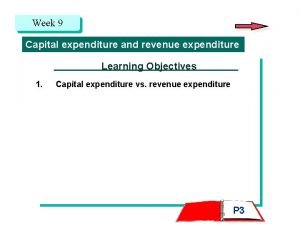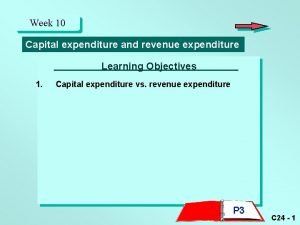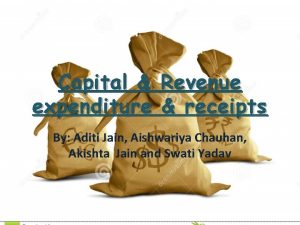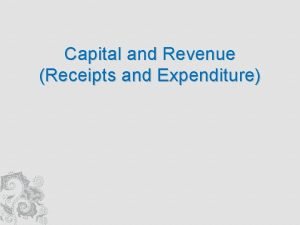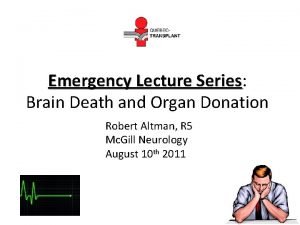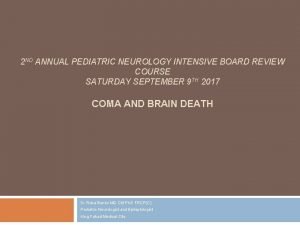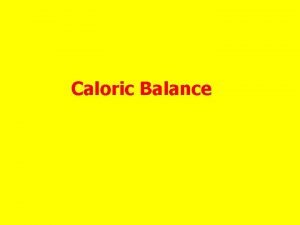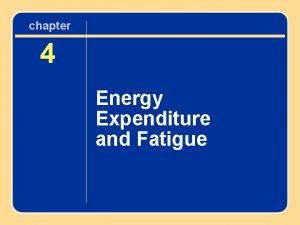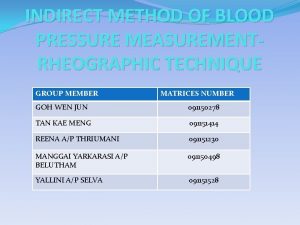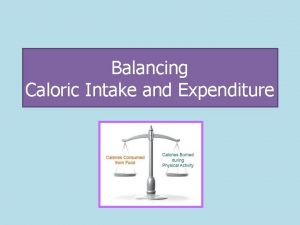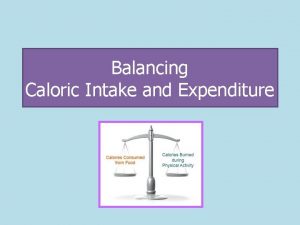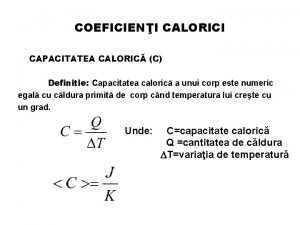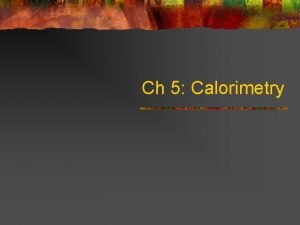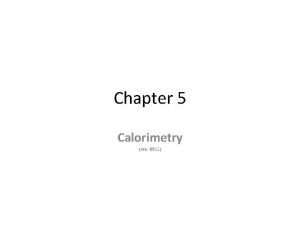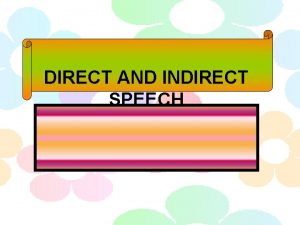Measuring Energy Expenditure Direct Calorimetry Indirect Calorimetry Caloric















- Slides: 15

Measuring Energy Expenditure

�Direct Calorimetry �Indirect Calorimetry

�Caloric Equivalents ▪ Carbohydrate – 5 Kcals/LO 2 ▪ Fat – 4. 7 Kcals/LO 2 ▪ Protein – 4. 5 Kcals/LO 2

�Expressing Energy Expenditure VO 2 LO 2/min and m. LO 2/kgbwt/min ▪ LO 2/min is absolute expression ▪ m. LO 2/kgbwt/min is relevant expression ▪ Expressed relevant to body weight Kcals/min – 5 Kcals/LO 2 METs – equivalent to 3. 5 m. LO 2/kgbwt/min Kcal/kg/hr – 1 Kcal/kg/hr = 1 MET

�Metabolic Equations Used to estimate oxygen cost v. O 2 for certain activities Typical standard deviation of 7 -9% Can be used to estimate maximal oxygen consumption from the last stage of a graded exercise test ▪ Certain pre-reqs apply if these equations are applied to a GXT – rate of progression must be slow, stage changes must be suitable to the subject. Need subject to reach steady state at each stage.

�Total oxygen cost = net cost of activity + 3. 5 mkm Net cost is considered voluntary cost ▪ In some equations broken down into horizontal and vertical costs v. O 2 = (0. 1 mkm/m/min) + (1. 8 mkm/m/min. %grade) + 3. 5 mkm Horizontal component Vertical Component

Walking Equation v. O 2 = (0. 1 mkm/m/min) + (1. 8 mkm/m/min. %grade) + 3. 5 mkm 0. 1 mkm/m/min is the expression of oxygen cost for every meter per minute of horizontal movement � 1. 8 mkm/m/min is the expression of oxygen cost for every meter per minute of vertical movement � Vertical movememtn is the product of horizontal speed (m/min and the grade expressed as a decimal fraction) � Equation losses accuracy at higher walking speeds. As walking speed exceeds 4 mph the mechanical efficeincy of walking for most indivudals decreases. �

Running Equation v. O 2 = (0. 2 mkm/m/min) + (0. 9 mkm/m/min. %grade) + 3. 5 mkm � � � Equation is appropriate to use any time the subject is truly running Oxygen cost of horizontal movement is doubled Vertical oxygen cost is decreased by half due to flight phase of running

Leg Ergometry Equation v. O 2 = (10. 8 ml/Watt/min. Watt ÷ kgbwt) + 7 mkm 10. 8 m. LO 2 per Watt is the oxygen cost associated with leg ergometry � METs are doubled to account for one resting MET and one MET for unloaded cycling or the oxygen cost for turning the pedals with no load on the flywheel �

Arm Ergometry v. O 2 = (18 ml/Watt/min. Watt ÷ kgbwt) + 3. 5 mkm � 18 m. LO 2 per Watt is the oxygen cost associated with arm ergometry

Stepping v. O 2 = (0. 2 mkm/step/min. steps/min) + (1. 33. 1. 8 mkm/m/min. m/Steps/min) + 3. 5 mkm 0. 2 mkm is the horizontal oxygen cost for every step Oxygen cost for every m/min of vertical work is 1. 8 mkm 1. 33 represents total work � � � 1 is positive work or work against gravity 0. 33 is an estimate of negative work of work with gravity; the downward phase of the step Negative work is somewhere between 20 and 40% of positive work, ACSM uses 33%

�To effectively use these equations you must know the following: 1 mph = 26. 8 m/min 1 Watt = 6 Kp-m/min kcals/min = mkm * kgbwt / 200 m. LO 2 /kcal

�Tom is walking at 3 mph on a 2% grade. What is his oxygen consumption and energy cost in Kcals/min? Tom weighs 70 kg. 3 mile/hr x 26. 8 m/min/mile/hr = 80. 4 m/min v. O 2 = (0. 1 mkm/m/min. 80. 4 m/min) + (1. 8 mkm/m/min. 80. 4 m/min. 0. 02) + 3. 5 mkm v. O 2 = 8. 04 mkm + 2. 89 mkm + 3. 5 mkm = 14. 43 mkm

� 14. 43 is the oxygen cost to estimate the caloric expenditure per minute use this equation: kcals/min = mkm * kgbwt / 200 m. LO 2 /kcals/min = 14. 43 mkm * 70 kg / 200 m. LO 2 /kcal Kcals/min = 1010. 1 m. LO 2/min / 200 m. LO 2 /kcal Kcals/min = 5. 05

�Tom wants to expend 350 Kcals every time he walks. How long will he have to walk at this pace and grade to achieve this caloric expenditure? 375 Kcals ÷ 5. 05 Kcals/min = 74. 25 min
 What is capital and revenue expenditure
What is capital and revenue expenditure Revenue expenditure examples
Revenue expenditure examples What are the examples of revenue expenditure
What are the examples of revenue expenditure Capital expenditure vs revenue expenditure
Capital expenditure vs revenue expenditure Indirect reading instruments
Indirect reading instruments Hennebert sign
Hennebert sign Oculocephalic
Oculocephalic Cold caloric test brain death
Cold caloric test brain death Gita nath
Gita nath Pediatric gcs
Pediatric gcs Caloric balance definition
Caloric balance definition Haldane transformation equation
Haldane transformation equation Indirect form of solar energy
Indirect form of solar energy Rheographic method of blood pressure measurement
Rheographic method of blood pressure measurement Energy energy transfer and general energy analysis
Energy energy transfer and general energy analysis Energy energy transfer and general energy analysis
Energy energy transfer and general energy analysis
